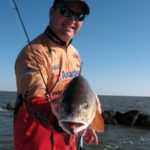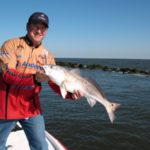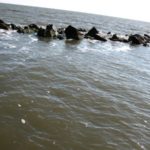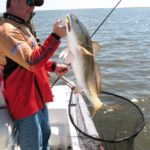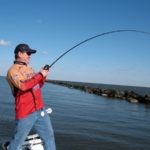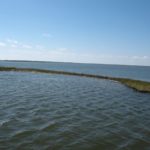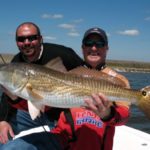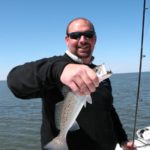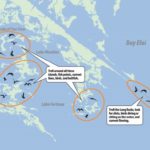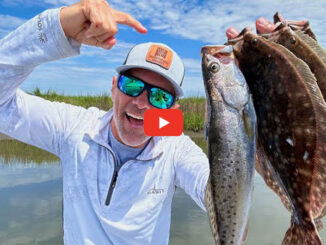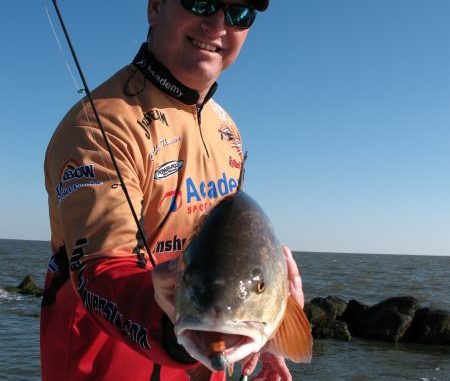
This month, catching trout and redfish doesn’t have to be difficult. All you have to do is fish the ‘in-between,’ where the fish are thick and the fishing pressure is almost non-existent.
Henry David Thoreau once said, “Everyone should believe in something; I believe I’ll go fishing.”
And if you believe that, as well, this is the month to go.
May brings those long-awaited southerly winds, and higher tides and saltier water — and all of that combines to sweep lots and lots of bait into our coastal waters, along with all the hungry predators we like to target.
It’s a fisherman’s dream.
Brown shrimp and small croakers show up in big numbers, and schools of speckled trout swarm in with their ravenous appetites to gorge themselves as birds dive overhead and anglers vie for all the prime fishing spots.
Yep, that’s May.
And I love to be right in the thick of it.
The biggest challenge is where to go! The good thing is that there are really no wrong choices anywhere along the Southeast Louisiana coast.
Capt. Charlie Thomason fishes out of Hopedale, and he likes to target an area in May he said is mostly ignored and therefore under-fished.
“I pretty much follow the same pattern every year because it’s been successful,” Thomason said. “You always have to look for variations in the pattern, because many things change from year to year.
“Where we fish we can be affected a lot by the river. A high river puts a lot of muddy water to the west of us on the Delacroix side, and all the action shifts a bit to the east. A low river keeps the action pretty evenly balanced everywhere.
“The point is that if I find muddy river water in my early spring hotspots, I’ll shift my hunt more toward the east and look for cleaner water. You always have to go with what nature gives you. Last year we had a cooler May and the trout action was slow getting started, but the redfish action was phenomenal. So now we’ll see what this May brings and so far the signs have been encouraging.”
Thomason considers May the precursor to the summertime trout explosion.
“May is still spring and not really summer yet,” he said. “Once summer arrives, the trout are all schooled up and you can often load up the boat in a single spot. That can happen in May, but usually the schools aren’t as large.
“We might catch 10 or 20 in a spot, and then you have to move.”
Where he likes to focus efforts on are areas overlooked by other anglers.
“This month I’ll fish the in-between areas that most people pass by,” Thomason said. “Lots of anglers fish to the east of it over along the Rocks to Bay Eloi, and most of the others will fish to the west on the west side of Bayou Terre Aux Boeuf in those bigger bays.
“The Rocks are the default dividing line between the east and west side — and me, I’ll be right in the middle of it all, from the rocks to the overlooked fringe bays just to the west, like Lake of Two Trees, Lake Calabasse, Pumpkin Bay and Lake Fortuna. I fish those lakes in May every year, and I rarely see another boat out there.”
That doesn’t mean his trips don’t require some work, but it’s usually worth the effort.
“One of the biggest challenges we face in May is consistency,” Thomason said. “Summer fishing is more predictable, but May usually offers some big fish — and school trout are everywhere.”
And he rarely resorts to live bait.
While Thomason said live bait is always a good idea to bring along in case the fish are finicky, but in May it’s not absolutely essential.
“We do the majority of our fishing under a cork, and we like to toss MirrOlure topwater baits, Corky’s, subsurface baits and swim baits,” he said. “We generally throw a mixture of soft baits, but I’ve been catching a lot on that Gulp! shrimp in the new penny color, either under a cork or just tight-lined.
“So I’ll fish that a lot until around mid-May, and then once summer actually arrives we switch almost entirely to live shrimp and live croakers.”
Thomason and his long-time buddy, Joey Luparello, invited me along to explore some of the in-between lakes and bays to see what we might bump into, and after a twist-and-turn run from his camp through the marsh, we pulled up to a series of marshy islands the guide wanted to try in Lake of Two Trees.
“There are a lot of islands out here with good points and coves, and any of them could hold fish,” Thomason said. “Naturally I like to fish places where I’ve caught fish before, but just fishing spots can make for an unproductive trip because conditions change. If the wind is different — maybe blowing harder or from a different direction — that makes a difference. Or if the tide is different — maybe a different range — falling harder or less or rising instead of falling, or the barometric pressure, or the temperature — any number of factors can change everything from one day to the next, and that is especially true in May, which I still consider something of a transition month. It’s the end of the transition, but it’s still not summer.
“So you have to fish conditions, and you have to fish opportunistically. That means (to) look for certain telltale signs to show you where the best chances are to catch something.”
Thomason said he looks for the same things every angler seeks: clean water, moving water, current lines and signs of bait in the water.
“And birds,” he said. “Don’t forget to look for birds this month. They will show you right where the shrimp are, and where the bait is, the trout are.
“But I particularly look for what I call ‘choke points’ around these islands, where the tide or the wind is pushing water through a pass or cut or opening. A place where the water flow is more restricted or concentrated and that forces bait through that opening: That is a choke point, and trout and reds and even flounder will lay in ambush right there waiting for the bait to come to them. That’s primarily what I’m looking for, and wherever I find that I’ll fish it. Look for a current line where the flow is coming out or a current line around a point. Fish that.”
Thomason said he catches nice trout in those areas — 16 to 18 inches long, not like the schoolies you normally catch under the birds this time of year.
“But what most people overlook when they see birds diving is those birds mean shrimp is in the area,” Thomason said. “I see a lot of boats just look at the birds and pass them up because they know the trout under them are small; and if they’re out in the middle of open water I often pass them up also.
“But if the birds are diving and there is land nearby, I don’t fish the birds, I fish the land. Small school trout are likely under the birds, but you can bet some bigger trout are lurking nearby, usually right along that nearby island or point. Sneak in quietly and fish there.”
Thomason had cut the outboard and crept up to a nice point with some current moving around it, using the trolling motor to make a silent approach.
“Cast up close to the point,” he said, indicating a grassy outcropping at the tip of the marsh island. “You don’t even have to be right on the point: You can cast behind it where the current is moving,.
Within seconds, Thomason had a hookup. A big fish made a short run and pulled enough line out to make the drag sing.
“Redfish,” we all said in unison.
And a nice red it was, the first of many for the day.
Soon both Luparello and I had redfish on, with the Gulp! shrimp in that new penny color proving its value by attracting one redfish after another at the points and coves along the broken islands.
Whenever the action died, Thomason moved us along to another likely spot, either by trolling there or —when the distance was farther — by cranking up his Honda outboard.
“I was hoping we’d catch a bunch of trout out here, but the redfish are swarming everywhere,” Thomason said.
After stocking up the ice chest with redfish he decided to leave the islands and head to the long rocks to see if any trout were at home.
“The Rocks really turn on in May,” Thomason said. “I start fishing them in April, and usually I can pick up some nice reds along the rocks — and some sheepshead and drum and trout.
“The bigger trout are generally hanging around the islands, so most of the trout you catch at the rocks will be school-sized, but plenty will be keeper-size.”
Thomason said he fishes the rocks under popping corks set between 3 to 5 feet deep.
“I’ll be mostly fishing plastics in early May, but I’ll switch to live shrimp out there around mid-month if the plastics stop performing,” he said. “One of my favorite tactics is to hook a small croaker on a Mustad croaker hook. It’s basically a No. 1 or No. 2 kahle hook with the eye set back at an angle so when a trout hits the croaker he pretty much hooks himself.
“We call it a ‘rookie-rig’ because anybody can catch fish on it — no experience necessary, that’s how effective it is.”
Thomason also is an avid tournament fisherman and has long experience on the trail of redfish.
“I fish rock jetties all over, and through the years I’ve learned a few things about fishing them and what to look for,” he said. “I know that jetties are good places to fish because fish like them, and there will be fish along them.
“I look for good water movement, either by tide or wind or waves, and I fish the current spots. I’ve learned how crucial it is to use your trolling motor when fishing the rocks. Troll and cast, troll and cast, troll and cast. And when you find fish, I try to turn the back of my boat toward the rocks where it’s a shallower so I can stick the Power-Pole, or if that’s not possible I’ll slip the anchor over as quietly as possible. Sometimes we’ll catch quite a few fish at one spot, both reds and specks, and sometimes it’s just a fish or two at a spot. If nothing else hits in five or 10 minutes, resume trolling.”
While he’s working the rocks, he watches for any sign of bait.
“Another thing I look for is birds diving along the rocks or even just sitting on the surface,” Thomason said. “Often there will be shrimp under them, and where the shrimp are the fish are.
“Also look for slicks. Sometimes I’ll just run the boat along the rocks until I see a slick or I see current coming through the rocks. I always stop to fish that.”
Thomason said he prefers fishing the long rocks over the short rocks, and he likes to fish the ends and the Cut.
“I fish the ends at both sides of the gap where the Corps removed a section of the rocks to build the dam at Hopedale,” he said. “You almost always see boats at the gap in May and all throughout the summer because it often pays off with some nice fish.
“Another good and popular spot is behind the Cut where boats turn off toward the Delacroix side. You can always find some calmer water behind the Cut on windy days, and while action there is inconsistent you can salvage a trip there on those days it does produce.”
But the area is almost bulletproof.
“I love to fish the rocks in May because you can almost always find fish there, and the rocks are one of the few places in the world where you can still catch trout when the dolphins are swimming all around your boat,” Thomason said. “Anyplace else you fish, you know, if the dolphins show up the trout bite will end because the specks will scatter. But for some reason that doesn’t happen at the rocks.
“We catch trout after trout while the porpoises are swimming all around us. I can’t explain it, but I’ve experienced it so many times I know it to be true.”
What else we found to be true was that the reds were stacked up at the rocks, and they hit our Gulp!s, our swim baits and just about everything else we tossed that day.
Thomason said if you choose not to buy live shrimp for your trip, at least bring some dead shrimp to tip your jigs for the reds. You’ll be glad you did.
Capt. Charlie Thomason can be reached at 504.278-3474.
